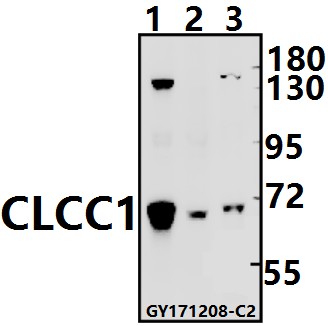Product Name :
CLCC1 (D429) polyclonal antibody Background :
Chloride channels (CLCs) regulate cellular traffic of chloride ions, a critical component of all living cells. CLCs are involved in membrane potential stabilization, signal transduction, cell volume regulation and organic solute transport. CLCC1 (Chloride channel CLIC-like protein 1), also known as MCLC (Mid-1-related chloride channel) or KIAA0761, is a 551 amino acid multi-pass membrane protein that belongs to the chloride channel MCLC family. CLCC1 is related to the Saccharomyces cerevisiaeprotein Mid-1 and is believed to function as an intracellular chloride channel that is expressed in lung, brain, muscle, liver and testis. Localizing to intracellular compartments such as the Golgi apparatus, the endoplasmic reticulum (ER) and the nuclear envelope, CLCC1 is expressed as four isoforms due to alternative splicing events, namely hMCLC-1, hMCLC-2, hMCLC-3 and hMCLC-4. Product :
Rabbit IgG, 1mg/ml in PBS with 0.02% sodium azide, 50% glycerol, pH7.2 Storage&Stability :
Store at 4°C short term. Aliquot and store at -20°C long term. Avoid freeze-thaw cycles. Specificity :
CLCC1 (D429) polyclonal antibody detects endogenous levels of CLCC1 protein. Immunogen :
Synthetic peptide, corresponding to amino acids 396-445 of Human CLCC1. Conjugate :
Unconjugated Modification :
Unmodification
CLCC1 (D429) polyclonal antibody Background :
Chloride channels (CLCs) regulate cellular traffic of chloride ions, a critical component of all living cells. CLCs are involved in membrane potential stabilization, signal transduction, cell volume regulation and organic solute transport. CLCC1 (Chloride channel CLIC-like protein 1), also known as MCLC (Mid-1-related chloride channel) or KIAA0761, is a 551 amino acid multi-pass membrane protein that belongs to the chloride channel MCLC family. CLCC1 is related to the Saccharomyces cerevisiaeprotein Mid-1 and is believed to function as an intracellular chloride channel that is expressed in lung, brain, muscle, liver and testis. Localizing to intracellular compartments such as the Golgi apparatus, the endoplasmic reticulum (ER) and the nuclear envelope, CLCC1 is expressed as four isoforms due to alternative splicing events, namely hMCLC-1, hMCLC-2, hMCLC-3 and hMCLC-4. Product :
Rabbit IgG, 1mg/ml in PBS with 0.02% sodium azide, 50% glycerol, pH7.2 Storage&Stability :
Store at 4°C short term. Aliquot and store at -20°C long term. Avoid freeze-thaw cycles. Specificity :
CLCC1 (D429) polyclonal antibody detects endogenous levels of CLCC1 protein. Immunogen :
Synthetic peptide, corresponding to amino acids 396-445 of Human CLCC1. Conjugate :
Unconjugated Modification :
Unmodification
-
 Western blot (WB) analysis of CLCC1 (D429) pAb at 1:500 dilution Lane1:SGC7901 whole cell lysate(40ug) Lane2:HCT116 whole cell lysate(40ug) Lane3:H1792 whole cell lysate(20ug)
Western blot (WB) analysis of CLCC1 (D429) pAb at 1:500 dilution Lane1:SGC7901 whole cell lysate(40ug) Lane2:HCT116 whole cell lysate(40ug) Lane3:H1792 whole cell lysate(20ug)
Bioworld Biotech only provide peptides for our antibodies and do not provide additional peptide customization services.
Price/Size :
USD 368/1mg/vial
Tips:
For phospho antibody, we provide phospho peptide(0.5mg) and non-phospho peptide(0.5mg).Describe :
Blocking peptides are peptides that bind specifically to the target antibody and block antibody binding. These peptide usually contains the epitope recognized by the antibody. Antibodies bound to the blocking peptide no longer bind to the epitope on the target protein. This mechanism is useful when non-specific binding is an issue, for example, in Western blotting (WB) and Immunohistochemistry (IHC). By comparing the staining from the blocked antibody versus the antibody alone, one can see which staining is specific; Specific binding will be absent from the western blot or IHC performed with the neutralized antibody.Formula:
Synthetic peptide was lyophilized with 100% acetonitrile and is supplied as a powder. Reconstitute with 0.1 ml DI water for a final concentration of 10 mg/ml.The purity is >90%,tested by HPLC and MS.
Storage:
The freeze-dried powder is more stable. For short time at 2-8°C. For long term storage store at -20°C.
Note :
This product is for research use only (RUO only). Not for use in diagnostic or therapeutic procedures.
 CLCC1 (D429) polyclonal antibody
CLCC1 (D429) polyclonal antibody  Datasheet
Datasheet COA
COA MSDS
MSDS SHIP
SHIP